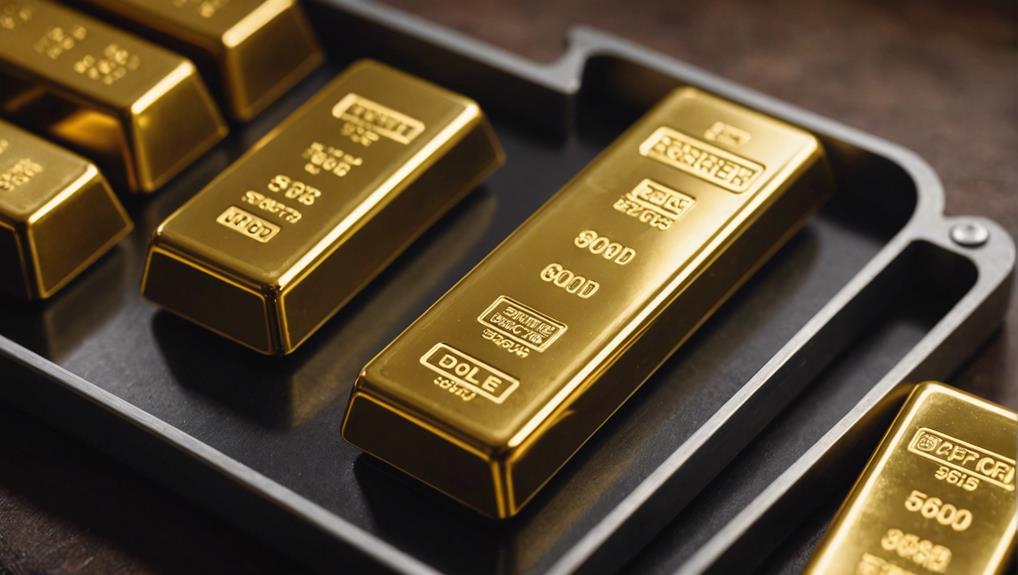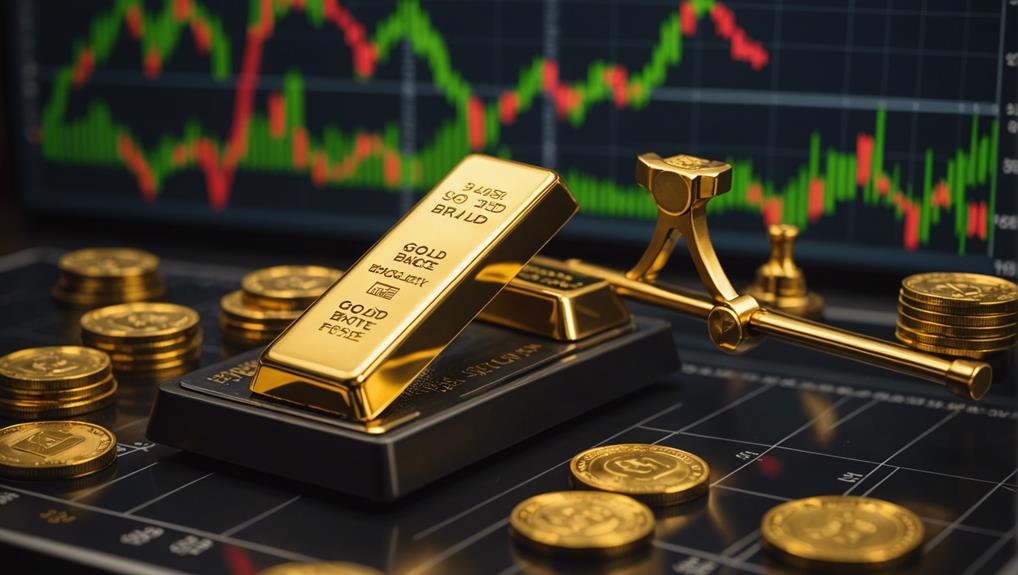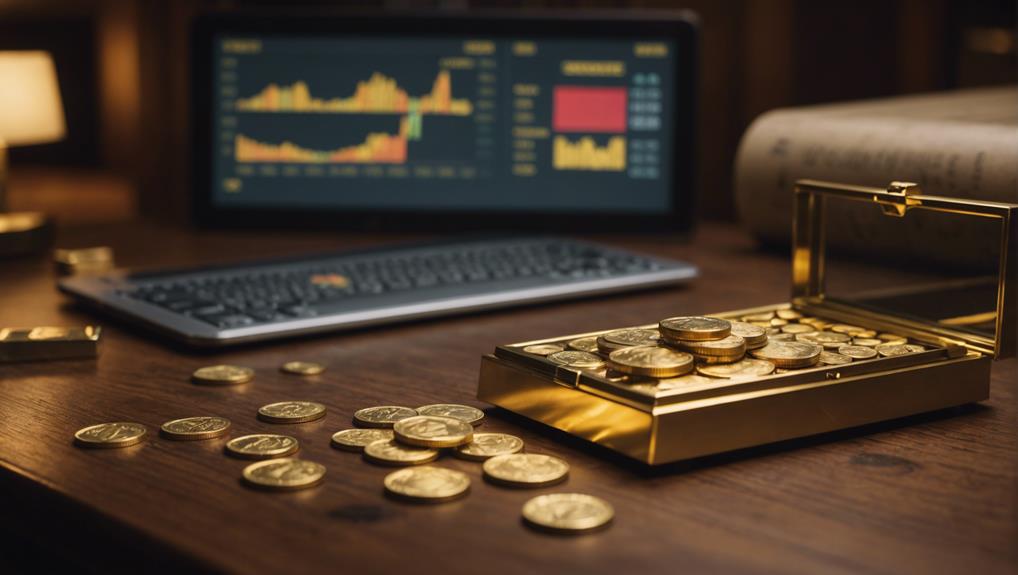Considering diversifying your portfolio in 2024? Investing in gold presents several compelling opportunities. Physical gold, gold ETFs, and gold mining stocks each offer distinct advantages and risks. Holding physical gold provides a tangible asset with historical value, while gold ETFs offer convenience and liquidity.
Gold mining stocks, though potentially high-yielding, come with their own set of risks. Balancing these investments can be crucial for navigating economic uncertainties. Which combination might work best for you? Let’s explore further.
My Quick Highlights
- Gold ETFs and Mutual Funds: Invest in gold exchange-traded funds (ETFs) and mutual funds for convenient access and portfolio diversification without owning physical gold.
- Physical Gold Investments: Consider buying gold bars, coins, or jewelry for tangible asset ownership and ease of liquidation.
- Gold Mining Stocks: Explore stocks of companies involved in gold production to gain indirect exposure to the gold market.
- Gold-Backed Cryptocurrencies: Investigate digital assets backed by gold for a modern investment combining the benefits of both digital and physical assets.
- Gold IRA Accounts: Use Individual Retirement Accounts (IRAs) to hold physical gold, leveraging tax advantages and potential appreciation for retirement planning.
Physical Gold Investments

Investing in physical gold, such as bars, coins, or jewelry, offers direct ownership of tangible assets. Gold bullion, including bars and coins, serves as a substantial store of wealth with historical value. Gold jewelry, while often appreciated for its aesthetic appeal, also functions as a valuable investment.
Secure storage options, such as safe deposit boxes or specialized facilities, are crucial when owning physical gold. Insuring your gold can protect against theft or loss. One significant advantage of holding physical gold is the ability to quickly liquidate it, providing financial flexibility.
This sense of security and ownership is why many investors prefer tangible assets.
Gold ETFs and Mutual Funds
Gold ETFs and mutual funds provide an accessible and efficient way to gain exposure to gold without needing to handle physical assets. These investment vehicles track the price of gold and offer diversified access to gold-related assets, making them convenient for investors. They can be easily bought and sold through brokerage accounts, ensuring liquidity and cost-effectiveness.
These assets can be bought and sold easily without dealing with physical gold.
Popular options include SPDR Gold Shares (GLD) and iShares Gold Trust (IAU).
Gold mutual funds offer diversified portfolios of gold-related investments.
Investment strategies: Ideal for diversifying your portfolio with indirect gold exposure.
Incorporating gold ETFs and mutual funds into your investment strategy can provide a balanced approach to portfolio diversification.
Gold Mining Stocks

Investing in gold mining stocks offers a way to gain indirect exposure to the gold market. By purchasing shares of companies involved in gold production, you can potentially benefit from gold price movements without the need to manage physical gold storage. Leading companies in this sector include Freeport-McMoRan, Royal Gold, and Newmont. The performance of gold mining stocks is influenced by factors such as production costs, reserve quality, and exploration success.
Top gold mining stocks are characterized by the following critical factors:
| Company | Critical Factor |
|---|---|
| Freeport-McMoRan | Production Costs |
| Royal Gold | Reserve Quality |
| Newmont | Exploration Success |
| Barrick Gold | Production Costs |
| Gold Fields | Reserve Quality |
Considering these factors can help investors make informed decisions when selecting gold mining stocks.
Gold Futures and Options
Interested in profiting from gold price movements without owning the metal? Gold futures and options might be your answer. These financial instruments allow you to speculate on future gold prices, offering high leverage and thus a greater profit potential. They also come with substantial risk, making them more suitable for experienced investors with a high-risk tolerance.
Before diving in, it’s crucial to understand both the risks and rewards associated with trading these instruments.
- High leverage: Amplifies both profits and losses.
- Speculative nature: Requires strong market expertise.
- Risk management: Essential to mitigate potential losses.
- Advanced tools: Ideal for seasoned investors.
Gold IRA Accounts

Investing in gold futures and options is a way to speculate on market movements, but incorporating gold into your portfolio can also be effectively achieved through a Gold IRA account.
A Gold IRA (Individual Retirement Account) allows you to hold physical gold—such as gold sovereigns—in a tax-advantaged retirement account. Roth gold IRAs offer similar tax benefits to regular IRAs, making them a strategic choice for retirement planning.
By investing pre-tax dollars, you can benefit from potential appreciation in the gold price index. Including gold reserves in your IRA diversifies your portfolio, providing a hedge against economic downturns.
Gold IRAs offer a secure method to integrate physical gold into your retirement strategy while maximizing tax advantages.
Factors Influencing Gold Prices
To make informed gold investments in 2024, you need to understand how economic indicators, geopolitical events, and supply and demand affect gold prices.
Economic factors like inflation and interest rates, along with geopolitical tensions, can cause significant price shifts.
Moreover, the balance between supply and demand plays an essential role in determining the value of gold.
Economic Indicators Impact
Interest rates, inflation, and geopolitical tensions significantly impact gold prices, making it essential to stay informed about these economic indicators. Gold prices often rise when interest rates are low, as investors seek alternatives to low-yielding assets.
Inflation erodes purchasing power, driving investors to gold as a hedge. Global economic stability influences gold prices; during instability, gold is a preferred safe haven.
Stay updated on these important economic indicators:
- Interest rates: Lower rates usually enhance gold demand.
- Inflation: High inflation often elevates gold prices.
- Economic policies: Policies affecting global economic stability can influence gold prices.
- Market uncertainties: Uncertain markets drive investors to gold for security.
Monitoring these factors helps you make informed gold investment decisions.
Geopolitical Events Influence
Economic indicators are crucial, but geopolitical events significantly influence gold prices as well. During conflicts, trade tensions, or political instability, investors often seek gold as a safe-haven asset. This increased demand typically drives gold prices higher.
Market trends reflect this, showing elevated prices during periods of geopolitical uncertainty and global unrest. By seeking stability and wealth preservation amid these risks, investors contribute to the rising value of gold.
Understanding how geopolitical events impact gold prices helps in making informed investment decisions, allowing you to capitalize on market movements. Monitoring global news and political developments is essential for anticipating shifts in gold prices, ensuring readiness to act promptly.
Supply and Demand
Several significant factors drive the dynamics of gold’s supply and demand, directly influencing its price. Both supply and demand aspects must be considered for accurate gold price forecasting and understanding market volatility.
- Gold Supply: Key elements include mining production, central bank reserves, and scrap gold recycling.
- Gold Demand: Major factors are investments, industrial applications, and jewelry manufacturing.
- Global Economic Conditions: Economic growth, inflation rates, and interest rates significantly impact gold demand.
- Geopolitical Events: Factors such as wars, political instability, and trade tensions can disrupt the balance between supply and demand.
Benefits and Risks of Gold Investing

Investing in gold can help protect your portfolio against inflation, particularly with prices nearing record highs of $2,500 per ounce.
Gold offers a buffer during market volatility, making it a reliable option during economic uncertainty.
It’s important to evaluate the risks like price fluctuations, lack of income generation, and storage costs for physical gold.
Inflation Hedge Potential
Gold is often seen as a reliable hedge against inflation, making it a popular choice for investors aiming to preserve their purchasing power. Investing in gold can help maintain value when the cost of goods rises.
Key aspects to consider include:
- Gold spot price: The current market price for gold, which is crucial for making informed trades.
- Gold trading platforms: Online platforms that facilitate easy buying and selling of gold.
- Gold-backed cryptocurrencies: Digital assets tied to gold, providing a modern alternative to traditional gold investments.
- Intrinsic value: Gold’s inherent worth, attributed to its limited supply and historical significance.
While gold can protect against inflation, it’s essential to consider the potential for price volatility.
Market Volatility Impact
When evaluating gold’s role as an inflation hedge, it’s crucial to consider how market volatility affects the benefits and risks of gold investing. During economic uncertainty, gold is often regarded as a safe haven, with prices generally rising.
Investing in gold, including gold ETFs, can provide portfolio stability amid stock market downturns. Historically, gold’s performance during geopolitical tensions and crises demonstrates its value for diversification. However, risks include price fluctuations, no income generation, and storage costs for physical gold. Consider implementing effective strategies for investing in gold stocks.
Central banks’ policies and the absence of a gold standard also influence gold’s market behavior. Understanding these factors is essential for making informed decisions about investing in gold during volatile times.
Liquidity and Accessibility
Gold is a highly liquid asset that can be quickly converted to cash. Physical gold can be sold to gold dealers or refiners at market prices.
Top gold ETFs in 2024 offer immediate liquidity on stock exchanges, making them a convenient option for investors.
Another alternative is gold certificates, which represent ownership without the hassle of storing physical gold.
- Gold ETFs: Easily traded on stock exchanges, providing immediate liquidity.
- Gold Certificates: A paper form of gold ownership, reducing storage concerns.
Gold refiners can convert physical gold into sellable forms, enhancing liquidity.
Gold dealers facilitate the buying and selling of physical gold at market prices.
Price volatility, however, can influence the ease of selling your gold investments.
Conclusion
In 2024, expanding your portfolio with gold can be achieved through various investment methods such as physical gold, gold ETFs, gold mining stocks, futures, options, and Gold IRA accounts. Each investment method offers unique benefits and risks, helping you safeguard against economic uncertainties.
Understanding how various factors influence gold prices and carefully selecting your investment options can effectively hedge your assets and potentially increase your portfolio’s resilience. Assess your risk tolerance and financial goals before making any decisions.
The Gold Information Network
11900 Biscayne Blvd, Ste 127B
Miami, FL 33181
(305) 449-9094
https://goldinfo.net







